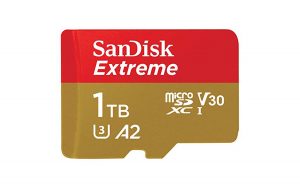
A SanDisk 1TB microSD card.
If your computer recognizes your flash card but presents an incorrect capacity, it’s probably due to firmware issues.
Firmware is specialized software that provides basic instructions to your computer, enabling your machine to read the target device.
If firmware becomes corrupt, or if it’s badly outdated, the computer cannot understand how to read your memory card — and the system can’t correctly identify the card’s capacity.
While firmware issues are the most common cause of this symptom, other scenarios can create the same issue:
- Your memory card reader may be damaged, or may have a corrupt/outdated driver.
- Some memory card sellers intentionally change the card’s firmware to make it appear to have a much larger capacity. Read about a common flash drive scam.
- The card may be formatted in a filesystem that your operating system is unable to read.
The quick solution is to update the firmware and reformat your memory card, but this permanently destroys all data on the device. If you need the files, contact a professional data recovery provider as soon as possible.
We do not recommend using flash recovery utilities on SD, microSD, CompactFlash, or other flash formats. Commercial data recovery software may contribute to file corruption and reduce the chances of a successful recovery.
Why causes flash card firmware corruption?
All data storage devices are susceptible to corruption, which simply refers to errors that occur during common operations (reading, writing, or processing the data).
As the name implies, firmware is intended to be constant: Unless you’re actively updating your firmware, it isn’t supposed to change. For that reason firmware corruption is considerably less common than other types of data corruption.
However, firmware can still become corrupt for a number of reasons:
- You unplug your memory card while the computer is still reading/writing data.
- Your computer shuts down unexpectedly.
- Your memory card sustains electrical damage from a power surge.
- Your memory card sits in storage for an extended period of time.
- Damage occurs due to a virus or other type of malicious software.
In most cases, firmware corruption occurs without any warning. Ideally, you’ll have a backup ready to go — but if you’re reading this article, there’s a good chance that’s not the case.
Can you recover data from a flash card with firmware damage?
Yes, but if a memory card reports an inaccurate capacity, it usually requires treatment in a professional data recovery laboratory.
Engineers will likely utilize “chip-off” recovery techniques, which means that the memory chip is removed from the original device. This requires specialized hardware and software, but the chances of a successful recovery are fairly high.
Some data recovery software vendors claim to be able to restore files from devices with firmware damage — but if the computer can’t read basic information from the memory card, neither can the software. If you absolutely need the data, we strongly recommend working with a professional data recovery provider.
If you decide to format the card and lose your data, be aware that firmware problems can indicate that the card is approaching the end of its service life. Do not store important data on the reformatted memory card (or keep a backup in another location).
Data Recovery for Flash Media Cards
Datarecovery.com provides recovery services for all flash media formats, including:
- Secure Digital (SD), microSD, and SDHC
- MultiMediaCard (MMC)
- CompactFlash (CF)
- xD-Picture Cards
- USB Flash Drives
- XQD Cards
With free media evaluations and our no data, no charge guarantee, we provide professional services with complete peace of mind: If we’re unable to restore your files, you don’t pay for the attempt.
Get started by scheduling an evaluation at one of our full-service laboratories. To speak with an expert, call 1-800-237-4200.




